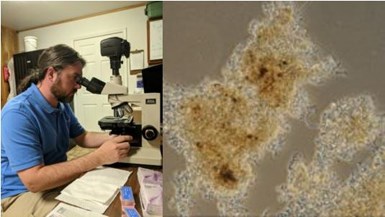Hubbard-Hall Acquires BioConversion Technology
The acquisition adds experience and biologics to the AquaPure product line.

Photo Credit: Hubbard-Hall
Hubbard-Hall acquired the assets of BioConversion Technology (BCT), a supplier of biologics and related chemistries for wastewater treatment. Jeremy Morgan, previously a vice president of technology at BCT, has joined Hubbard-Hall as product manager for biologics within the company’s AquaPure product line of wastewater specialties. Morgan is a graduate of Georgia Institute of Technology with a degree in chemical engineering and is a frequent speaker at water technology conferences. He reports to Robin Deal, AquaPure product manager.
BCT products are custom blends of specially selected bacterial strains for the metal finishing, food, pulp and paper, and petrochemical markets. The bacteria work under aerobic and anerobic conditions with no caustics or acids so as to not cause harm to pipes or wastewater equipment. BCT, formerly headquartered in Georgia, was founded in 2000 by Kathleen Renzi.
“The BCT line of products, combined with Jeremy’s expertise in biologics, round out our offerings to our industrial customer base,” says Hubbard-Hall CEO Molly Kellogg. “Bioaugmentation in metal finishing wastewater treatment is becoming more common as limits continue to tighten around Phosphorus, FOG and BOD. We now have a broader line to help our customers and, as always, the best technical team in the business.”
Related Content
-
NASF/AESF Foundation Research Project #122: Electrochemical Approaches to Treatment of PFAS in Plating Wastewater - 12th Quarterly Report
This NASF-AESF Foundation research project report covers the 12th quarter of project work (October – December 2023) at the University of Georgia. In our previous report, we described our work on performance and effect of surface fluorinated Ti4O7 anodes on PFAS degradation in reactive electrochemical membrane (REM) mode. This quarter, our experiments involved utilizing porous Ti4O7 plates serving both as anodes and membranes. Tests compared pristine and F-18.6 Ti4O7 anodes at current densities of 10 mA/cm2 and 40 mA/cm2. This 12th quarterly report discusses the mechanisms of the effects on EO performance by anode surface fluorination.
-
Explore Cleaning Chemistry, Metal Finishing Applications and Wastewater Treatment Solutions
Hubbard-Hall Celebrating 175 years of excellence, Hubbard-Hall presents chemistry and equipment.
-
NASF/AESF Foundation Research Project #120: Electrochemical Destruction of Perfluorooctanesulfonate in Electroplating Wastewaters - April 2022-March 2023
This NASF-AESF Foundation research project report covers project work from April 2022 to March 2023 at the University of Illinois at Chicago. The overall objective of this work is to utilize a cost-effective reactive electrochemical membrane (REM) for the removal of PFAS from synthetic electroplating wastewater. Initial results for the oxidation of PFOA with three different catalysts are discussed.








.jpg;maxWidth=300;quality=90)



